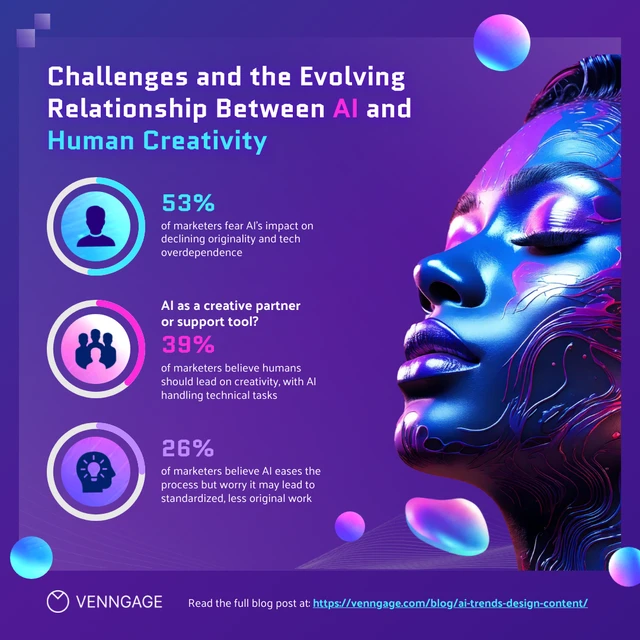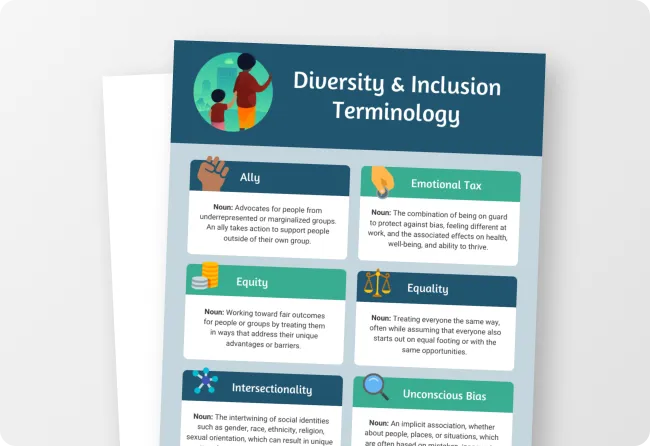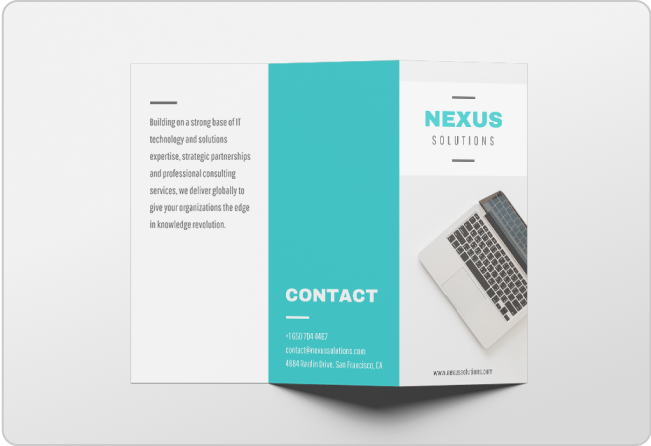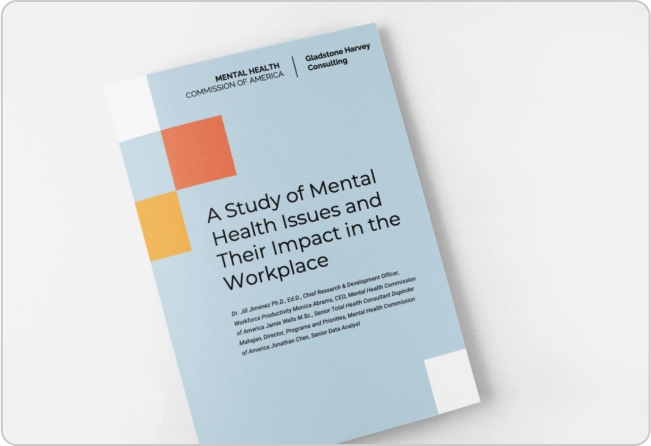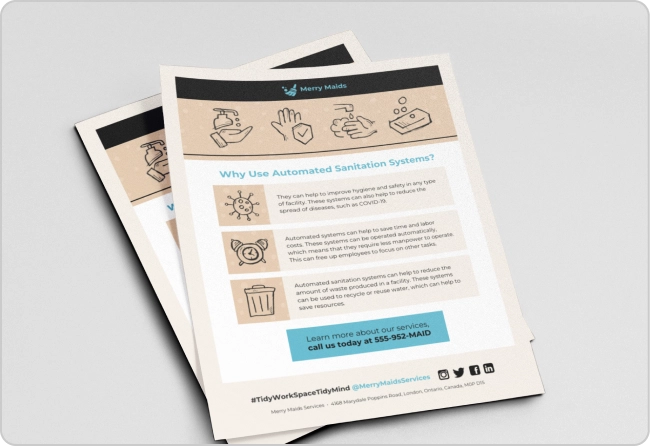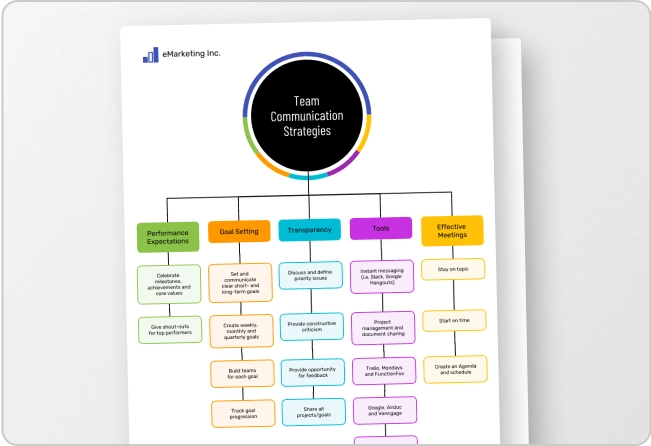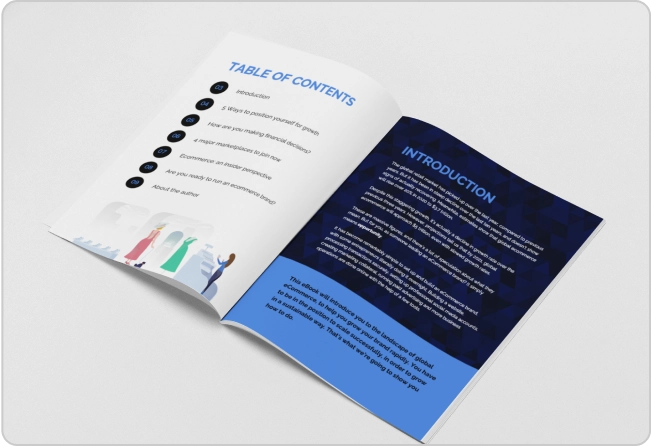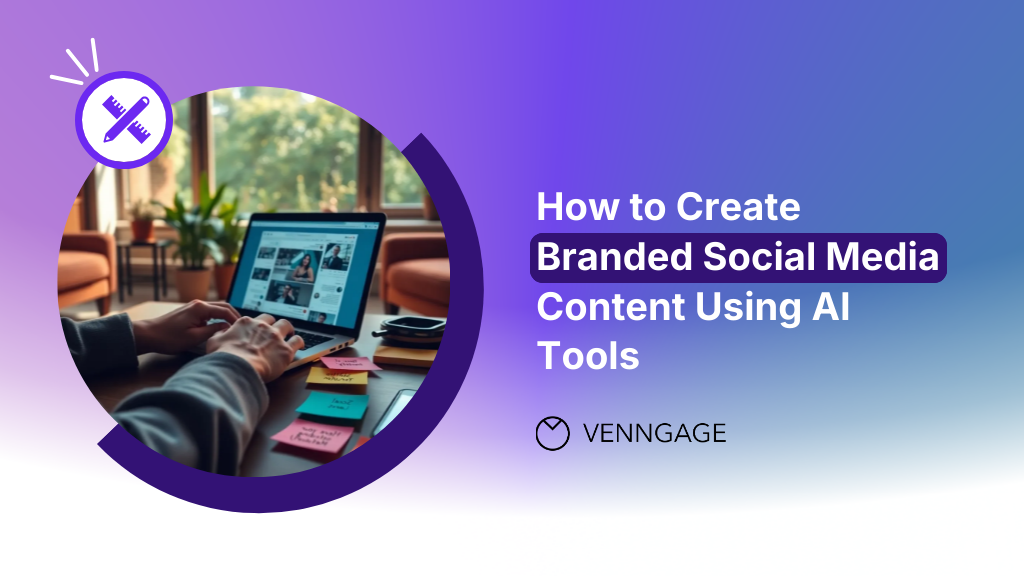
Creating branded social media content consistently used to require dedicated design teams and hours of manual work. Today, AI-powered tools can generate professional, on-brand content in minutes while maintaining your unique visual identity and voice across all platforms.
This comprehensive guide covers everything you need to know about using AI tools for social media content creation, from selecting the right platforms to implementing brand consistency at scale.
AI-powered social media content creation uses artificial intelligence to generate, optimize and customize social media posts while maintaining brand consistency. AI graphic design tools and content generators analyze your brand guidelines, visual assets and content preferences to automatically create social media posts that match your brand style.
Key capabilities of AI content creation tools:
- Visual generation: Creates graphics, layouts and design elements that match your brand colors, fonts and style.
- Text optimization: Generates captions, headlines and copy in your brand voice.
- Multi-platform adaptation: Automatically resizes and reformats content for different social media platforms.
- Content personalization: Tailors messaging for specific audience segments.
- Batch processing: Creates multiple content variations simultaneously.
According to a report by CapeGemini, 71% of images on social media are generated using AI. This explains that brands, creators and even individuals are relying on AI for speed, volume and iteration. The baseline is no longer “designers create visuals”, but “AI creates visuals, humans refine.”
Let’s see the top AI graphic design tools and content tools to automate social media marketing.
1. Venngage’s AI Social Media Content Generator
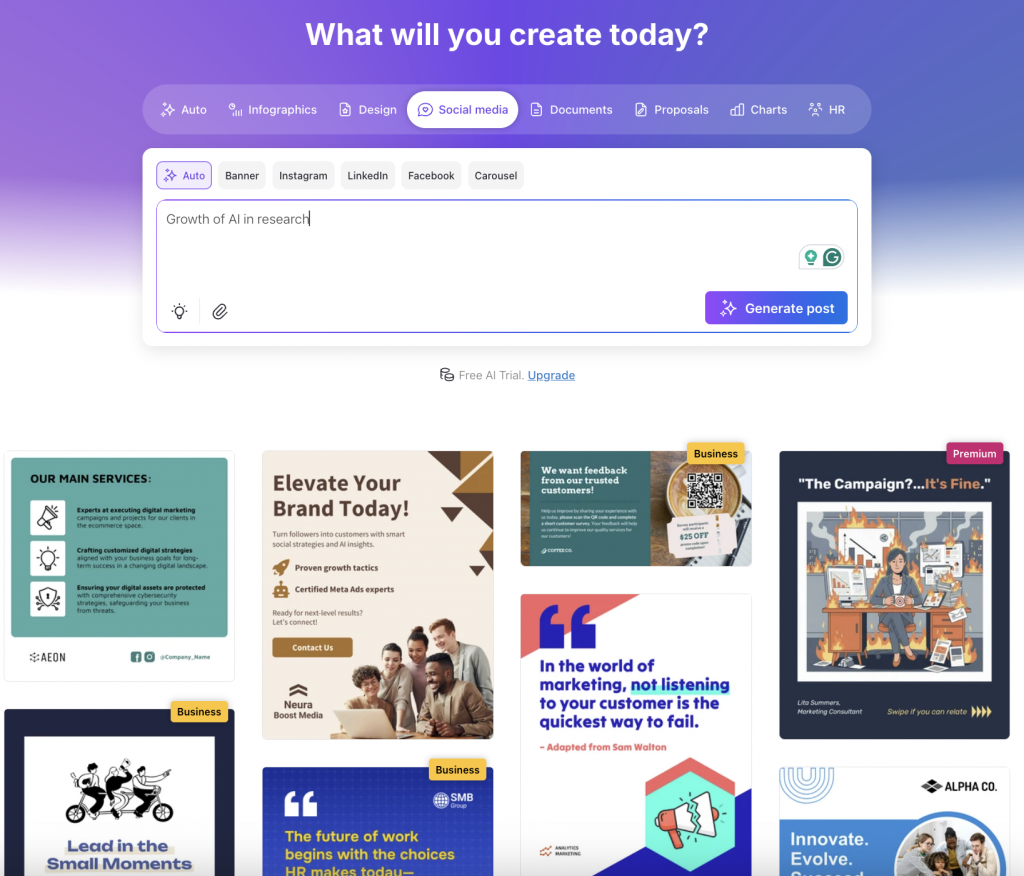
What it does: Venngage’s AI tool creates branded visual content, including social media posts, infographics and marketing materials with automatic brand application.
Best for: Businesses needing consistent, professional visual content across multiple platforms without dedicated design resources.
Key features:
- One-click brand application across all designs
- Smart template suggestions based on content type
- Multi-format export for different social platforms
- Brand kit integration for automatic color and font application
- Collaboration tools for team workflows
Limitations: Primarily focused on visual content; may require separate tools for video creation.
2. Canva AI (Magic Design)

Source: Canva
What it does: Generates social media designs using AI-powered template suggestions and automatic text and image placement.
Best for: Small businesses and individual creators who need quick design solutions with a minimal learning curve.
Key features:
- Extensive template library with AI recommendations
- Background removal and image enhancement
- Text-to-image generation
- Animation capabilities for stories and posts
Limitations: Limited customization options; designs can appear generic without manual refinement.
3. Jasper AI
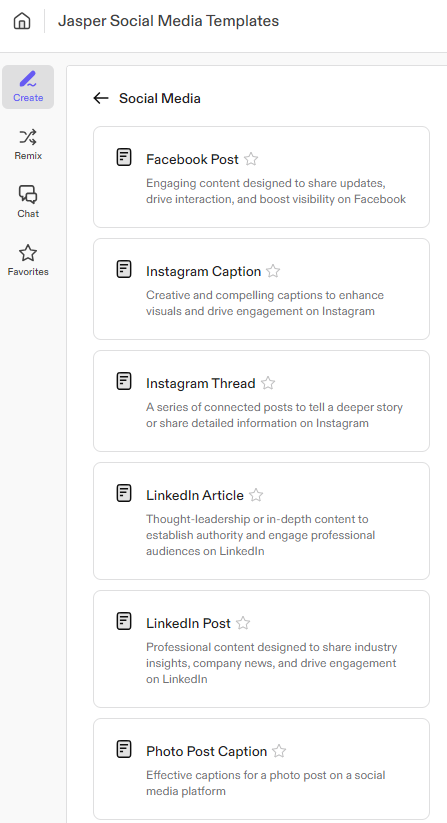
Source: Jasper
What it does: Specializes in AI-generated written content, including social media captions, blog posts and marketing copy.
Best for: Content marketers and businesses that prioritize written content and need a consistent brand voice across platforms.
Key features:
- Brand voice training and consistency
- Platform-specific content optimization
- Bulk content generation
- Integration with major social media management tools
Limitations: Focuses primarily on text; requires separate tools for visual content creation.
4. Buffer AI Assistant

Source: Buffer
What it does: Integrates AI content generation directly into social media scheduling and management workflows.
Best for: Social media managers handling multiple accounts who need streamlined content creation and posting.
Key features:
- Integrated content creation and scheduling
- Performance-based content suggestions
- Hashtag optimization
- Cross-platform posting with format optimization
Limitations: AI features are supplementary to the main scheduling platform; less robust than dedicated content creation tools.
“71% of social media marketers embed AI tools into their strategies, and content made with AI outperforms non-AI versions.”
SQ Magazine
Step 1: Define your brand parameters
Before using any AI tool, establish clear brand guidelines that can be translated into AI parameters:
Visual elements could include:
- Primary and secondary color codes (hex values)
- Font families and sizing hierarchies
- Logo placement rules and variations
- Image style preferences (photography vs. illustration, color vs. black and white)
Voice and tone specifications:
- Formal vs. casual language preferences
- Industry terminology usage
- Audience engagement style (questions, statements, calls-to-action)
- Brand personality traits (professional, friendly, authoritative, playful)
Step 2: Set up platform-specific guidelines
Different social media platforms require different approaches while maintaining brand consistency:
- LinkedIn requires a more professional tone, with industry insights, longer-form explanations, and business-focused imagery or graphics that support thought leadership.
- Instagram works best with a visual-first approach that uses compelling imagery, casual and engaging captions and story-friendly vertical formats.
- Twitter/X calls for concise, impactful messaging that supports real-time conversations and responds quickly to news or trends.
- Facebook is more community-driven, benefiting from a mix of visual and text-based posts, along with longer captions that allow for richer storytelling.

Step 3: Train your AI tools
Most effective AI content creation requires initial setup and ongoing refinement:
- Upload brand assets: Import logos, color palettes, fonts and existing content examples
- Set content parameters: Define preferred post types, messaging themes and visual styles
- Generate test content: Create sample posts and evaluate alignment with brand standards
- Refine and iterate: Adjust parameters based on initial results and team feedback
Step 4: Create content workflows
Build a structured process for how you’ll create and manage AI-generated content:
- For daily content creation: Generate several post variations for each platform, review them to identify the strongest option and schedule the approved posts using your preferred scheduling tool.
- For weekly batch creation: Map out your themes and campaign priorities, create all posts for the upcoming week in one focused session and complete a final review before scheduling everything in advance.
Why brand consistency matters in AI-generated content?
Brand consistency builds recognition and trust with your audience. According to a study by LucidPress, “Consistent brand presentation across all platforms can increase revenue by up to 23%.” When AI-generated content maintains consistent visual and messaging elements, it creates a cohesive brand experience that audiences learn to recognize instantly.
Benefits of consistent AI-generated content:
- Increased brand recognition: Consistent visual elements make your content instantly identifiable
- Improved audience trust: Reliability in presentation builds credibility
- Enhanced engagement: Familiar formatting and style reduce cognitive load for viewers
- Scalable quality: Maintains professional standards across high-volume posting
Measuring brand consistency:
- Run a monthly visual audit across all platforms
- Compare engagement rates between branded and non-branded posts
- Track brand mentions and sentiment over time
- Collect audience feedback through quick recognition or perception surveys
Each platform has unique audience expectations and content formats, but your core brand voice should remain recognizable across all channels.
Platform adaptation strategies
Professional platforms (LinkedIn, Twitter): • Use industry terminology appropriately • Share insights and thought leadership content • Maintain authoritative but approachable tone • Focus on value-driven messaging
Visual platforms (Instagram, TikTok): • Embrace more casual, authentic visual communication style • Use platform-specific language and trends • Prioritize visual storytelling over text-heavy content • Engage with community-style interactions
Community platforms (Facebook, Reddit): • Encourage conversation and discussion • Share behind-the-scenes and personal brand content • Respond to comments in brand voice • Participate in relevant community discussions
Voice consistency techniques
Core message frameworks: Develop key messaging pillars that can be adapted to different platforms while maintaining consistency.
Tone modulation: Adjust formality levels for different platforms while keeping personality traits consistent.
Content themes: Maintain consistent topics and perspectives across platforms, varying only the presentation format.
Creating engaging visual content with AI design tools
Visual content drives significantly higher engagement rates across all social media platforms. Posts with images produce 650% higher engagement than text-only posts. AI design tools can help create professional, branded visuals without requiring design expertise.
Visual content formats to prioritize:
- Static graphics focus on branded quote cards, data visuals, infographics, product showcases and behind-the-scenes photography. These formats help establish a clear visual identity and keep your feed looking consistent and professional.
- Animated content works well for highlighting key messages through simple motion graphics, animated logos, slideshow stories and short GIF-style demos. These formats add movement and attention-grabbing elements without requiring heavy production.
- Platform-optimized formats include Instagram Stories and Reels templates, LinkedIn carousels, Twitter headers and Facebook event covers. Tailoring visuals to each platform ensures your content displays correctly while still feeling cohesive across channels.
Design best practices for AI tools
- Color strategy: Use your primary brand colors for 60% of design elements, secondary colors for 30% and accent colors for 10% to maintain visual balance.
- Typography hierarchy: Establish clear font sizes and styles for headlines, body text and captions that AI tools can replicate consistently.
- Layout principles: Define spacing, alignment and composition rules that create visual consistency across all generated content.
- Brand element placement: Specify where logos, icons and other brand elements should appear in different content formats.
According to Survey Monkey, 43% of marketers report that AI is essential to their social media strategy.
Scaling your content creation process with AI
AI tools excel at creating large volumes of content while maintaining quality and brand consistency. AI-powered content creation platforms can reduce content creation time by up to 90%. Effective scaling requires strategic planning and systematic execution.
Batch content creation strategies
Monthly planning sessions:
- Identify key events, promotions and content themes
- Generate content calendars with AI assistance
- Create base templates for recurring content types
- Establish approval workflows for team review
Weekly execution cycles:
- Generate multiple content variations for A/B testing
- Create platform-specific adaptations of core content
- Produce evergreen content for scheduling gaps
- Develop trending topic response templates
Content variation techniques
- Message adaptation: Transform single concepts into multiple platform-appropriate formats.
- Visual variations: Create different design approaches for the same message to test audience preferences.
- Timing optimization: Generate content variations optimized for different posting times and audience segments.
- Seasonal customization: Adapt core content themes for holidays, industry events and trending topics.
Measuring Success and Optimizing AI-Generated Content
Success measurement for AI-generated content requires tracking both traditional social media metrics and brand-specific indicators that reflect consistency and recognition.
Key performance indicators
Engagement metrics show how your audience responds to AI-generated content. Track likes, shares and comments compared to manually created posts, along with click-through rates, story completion, interaction levels and overall video watch time.
Brand consistency metrics help you understand how well your visuals align with your identity across platforms. Measure visual consistency from monthly audits, monitor sentiment and recognition, check hashtag performance and gather feedback on how easily audiences identify your brand.
Efficiency metrics reveal the operational impact of AI in your workflow. Compare content creation time, cost per asset, total output volume and overall productivity improvements against your previous process.
Optimization strategies
- Performance analysis: Review top-performing AI-generated content monthly to identify successful patterns and elements.
- A/B testing: Compare AI-generated content against manually created content to understand relative performance.
- Audience feedback integration: Use comments, direct messages and survey responses to refine AI content parameters.
- Platform algorithm adaptation: Adjust content strategy based on platform algorithm changes and performance trends.
Understanding common pitfalls helps prevent issues that can undermine your AI content strategy’s effectiveness.
Over-automation issues
- Complete hands-off approach: AI requires human oversight to ensure content remains relevant, timely and appropriate for current events.
- Ignoring audience feedback: Failing to incorporate user responses and engagement patterns into content optimization.
- Generic template overuse: Relying too heavily on standard templates without customization can make content appear impersonal.
Brand consistency failures
- Insufficient brand guidelines: Vague or incomplete brand parameters lead to inconsistent AI output.
- Platform confusion: Using identical content across platforms without adapting to specific audience expectations.
- Voice drift: Failing to regularly review and adjust AI-generated content can lead to gradual brand voice changes.
Content quality problems
- Lack of human review: Publishing AI content without editorial oversight can result in errors or inappropriate messaging.
- Missing context awareness: AI may not understand current events, trending topics, or sensitive timing issues.
- Repetitive patterns: Over-relying on AI without variation can create predictable, boring content patterns.
AI social media tools continue evolving rapidly, with new capabilities emerging that will transform how brands create and distribute content. Here are the AI design and content creation trends that will have the biggest impact on social media marketing.
Emerging technologies
- Real-time personalization: AI tools that analyze individual user preferences and create personalized content variations in real time.
- Advanced video generation: AI-powered video creation tools that can generate branded video content with minimal input.
- Cross-platform optimization: Intelligent systems that automatically adapt content for optimal performance on each specific platform.
- Predictive content creation: AI that anticipates trending topics and creates relevant content before trends peak.
Integration developments
- Unified content ecosystems: Platforms that integrate content creation, scheduling, analytics and optimization in a single workflow.
- Advanced collaboration tools: AI systems that facilitate team collaboration while maintaining brand consistency across multiple creators.
- Performance prediction: AI that can forecast content performance before publication based on historical data and current trends.
Begin your AI content creation journey with clear objectives and realistic expectations. Most successful implementations start small and scale gradually as teams become comfortable with the tools and processes.
Implementation Steps
Phase 1: Foundation setup (Week 1-2) • Define comprehensive brand guidelines • Select primary AI tools based on content needs • Train team members on tool usage • Create initial content templates and parameters
Phase 2: Testing and refinement (Week 3-6) • Generate test content across platforms • Compare performance against existing content • Refine brand parameters based on results • Establish review and approval processes
Phase 3: Scaling and optimization (Week 7+) • Increase content volume gradually • Implement batch creation workflows • Monitor performance metrics consistently • Optimize based on audience feedback and engagement data
Success Factors
- Clear brand vision: Well-defined brand guidelines translate into better AI outputs.
- Team training: Proper tool training ensures maximum effectiveness and consistency.
- Regular optimization: Continuous improvement based on performance data drives long-term success.
- Balanced automation: Maintaining human oversight while leveraging AI efficiency creates optimal results.
AI-powered social media content creation offers unprecedented opportunities to scale high-quality, branded content while reducing time and resource investment. By selecting appropriate tools, establishing clear brand guidelines and implementing systematic workflows, businesses can create engaging social media presences that drive meaningful audience engagement and support broader marketing objectives.
The key to success lies in viewing AI as a powerful creative partner rather than a complete replacement for human creativity and strategic thinking. When implemented thoughtfully, AI content creation tools become force multipliers that enable brands to maintain consistent, professional social media presences while focusing human resources on strategy, relationship building and high-level creative direction.




























